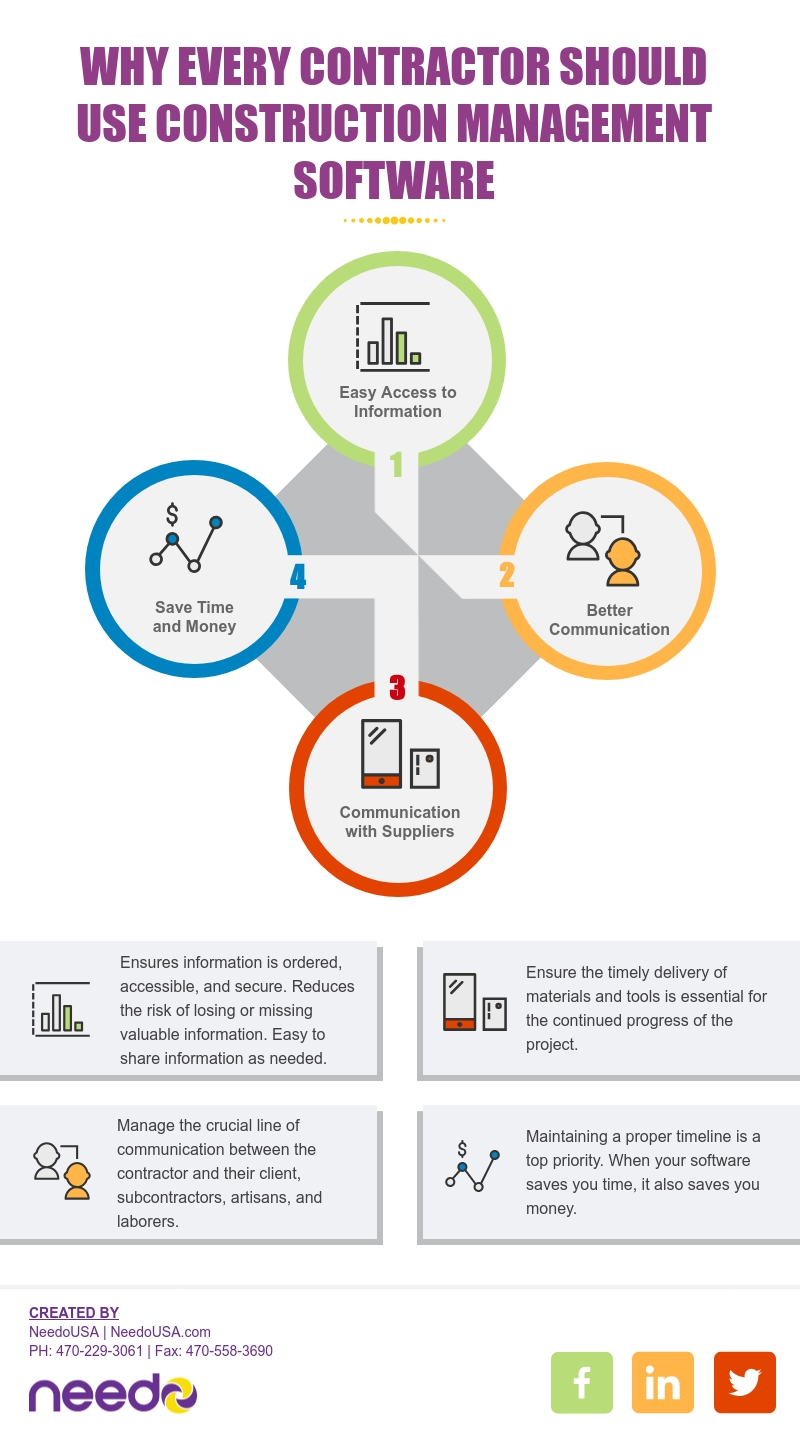Construction contracting, like every business sector, has benefited from the advancement of technology. Many contractors think that their primary skill set should include the tools, methods, and management of construction. But this would mean ignoring the vitally important business side of construction contracting. With the arrival of advanced technology in the construction field, every contractor should use construction management software to bolster their business and become a more successful entrepreneur.

Diverse Skills of a Construction Contractor
Succeeding as a contractor in the construction business takes a wide range of skills. The most obvious requirement for construction contractors is both skill and knowledge about construction. A contractor needs to be familiar with every sub-specialty they will be hiring. They also need to have skills and experience with a variety of construction methods, tools, and processes. All of these skills are an absolute necessity for a successful contractor.
However, to make the most of a construction contracting business, a contractor needs to have skills that fall well outside of the category of construction. A contractor is a small business owner and requires every type of advantage they can get in running a business. Unfortunately, many construction contractors neglect the business side of their contracting or at least don’t keep up to date with the latest advances.
Construction management software has been around for a while and is continuously advancing and evolving. What started out as some modified accounting and project management programs has become a whole new category of software. If you are a contractor and you are still running your business with piles of paper, it’s time to upgrade. Even if you are using some software, such as spreadsheets and accounting software, you could be doing much better.
There are many ways in which specialized construction management software can benefit your business. So there’s no reason to continue to ignore this vital tool in any contractor’s toolbox.
Easy Access to Information
One essential factor in construction project management is the ability to quickly and easily access information. The amount of data generated by a single project can be massive. There are invoices from subcontractors, vendors, materials, and tool rentals. There are schedules and status updates from everyone involved in the project. In addition, communications are constantly being generated, both official and unofficial. Everything from contracts to quick updates requires some form of written communication. With all of these individual pieces of data, you could soon find yourself buried under an avalanche of documents.
Construction management software can help relieve this glut of information. By giving you one central storage space for all of your information, the software ensures that your information is ordered, accessible, and secure. It reduces the risk of losing or missing valuable information. The software also makes it easy to share the information as needed. With everything available from the cloud, you can have your information on the go without having to go back to an office to find what you need.
Better Communication
When managing a construction project, whether it’s a small home renovation or complicated new construction, communication is critical. The contractor needs to manage their communication with a whole cast of players, always keeping track of what each one needs.
For one thing, any successful contractor needs to keep a clear and open line of communication with their client. A client needs to be kept abreast of the status of construction. Also, when a client contacts the contractor, the contractor needs to respond in a timely and professional manner. On more complex projects, the client may not be a single person. Instead, a contractor may have to deal with a client’s staff. This means carrying on several conversations at once over a period of days, weeks, or longer.
Another crucial line of communication is between the contractor and their subcontractors, artisans, and laborers. For a project to stay on schedule and proceed in an orderly fashion, everyone involved in the construction needs access to information relating to their job. Often, this means reaching out to the contractor. If a contractor loses track of one email chain or thread of communication, it could endanger an entire piece of the construction project. In fact, the slow-down or mistakes in one area can have a ripple effect, affecting all of the other parts of the construction project and causing severe problems.
Communicating with Suppliers
Any construction project will require expenditures on materials and possibly tools. Ensuring the timely delivery of materials and tools is essential for the continued progress of the project. To make sure that everything goes as planned, a contractor needs to be in touch with all of their vendors and suppliers. If a contractor drops the ball on a vendor, the whole project could grind to a halt until the issue is resolved. That puts a strain on the construction timeline and can ultimately be very costly.
When it comes to smoothing out and streamlining communication, construction management software was built with the contractor in mind. With the ability for everyone to access all of the information from the cloud, much of the necessary conversations can be eliminated. Other communications can be centralized and streamlined, making it easy to track all of the different relationships a contractor has.
Save Time and Money
When undertaking any construction project, maintaining a proper timeline is a top priority. In almost every case, the schedule of the project is written into the contract. There are an expected completion date and possibly deadline for various parts of the project along the way. This makes time a precious resource for contractors. Any way a contractor can save time creates a huge boost in efficiency and ability to deliver the product as promised.
Construction management software can save time in many different ways. First, it eliminates a lot of the time that is spent waiting for information to be shared among the people involved in the project. For example, workers and subcontractors can access the software remotely and log their progress and job status. This saves precious time for the contractor, who would have to inspect the worksite or seek out that information manually. With progress and status information available to everyone involved, work can proceed more quickly, avoiding lengthy lag time as goals are reached.
When your software saves you time, it also saves you money. The faster a job can responsibly proceed, the more projects you can take on as a contractor. More jobs mean more profits. Also, when a job takes less time, all of the various parties who are being paid for their time require a smaller expenditure. This could be tool rentals, hourly workers, or any other expense that increases over time. Clients also love to see progress, and if you can keep progress going at a reasonable rate, you will find yourself with great referrals. This is especially significant for the large portion of contractors who rely on referrals and reputation for most of their business.
Why Choose Needo
Needo software is software that is built with the end user in mind. Our products are created by people with experience in the field. These experienced construction workers know what it takes to stay on top of your game. Our designers are committed to the customer and to making software that fits your needs. We are responsive and consumer-based. Our programs are full of great features, and we are adding more all the time. Go ahead and contact Needo USA to find out how our products can make you more successful.


